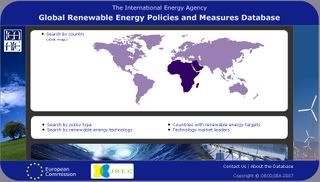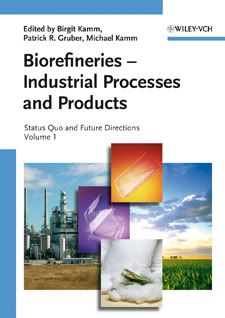Oman Green Energy Company makes ethanol from date palm, plans large refinery, 100 ethanol pumps by 2010
 Entrepreneurs based in the city of Sohar, Oman, want to turn the sultanate and oil producer into the first Arab country to use biofuels on a large scale. Mohammad Bin Saif Al Harthy and his partners at the Oman Green Energy Company claim they have been successfully producing and testing ethanol from biomass obtained from the abundantly present date palms for the last 18 months.
Entrepreneurs based in the city of Sohar, Oman, want to turn the sultanate and oil producer into the first Arab country to use biofuels on a large scale. Mohammad Bin Saif Al Harthy and his partners at the Oman Green Energy Company claim they have been successfully producing and testing ethanol from biomass obtained from the abundantly present date palms for the last 18 months.In an interview with Gulf News Al Harthy said that the production method does not affect the date crop nor does it require the removal of palm trees. Instead, cellulose biomass will be extracted from around 80,000 date palms in a 'non-intensive' way. The description of the process remains vague and could involve tapping glucose-rich sap from the tree, a technique which would however be very labor-intensive (see here for an Algerian biotech company that simply uses the sugar-rich fruits).
 Sugars in dates consist of a mixture of sucrose, glucose and fructose. Traditionally, dates have been used more to make date palm wine, alcohol, syrup and liquid sugar than as fruits. Dates belong to the sweetest of all fruits, with a sugar content ranging from 45 to 85% on a dry weight basis (table, click to enlarge). So in principle, they make for an interesting biofuel feedstock.
Sugars in dates consist of a mixture of sucrose, glucose and fructose. Traditionally, dates have been used more to make date palm wine, alcohol, syrup and liquid sugar than as fruits. Dates belong to the sweetest of all fruits, with a sugar content ranging from 45 to 85% on a dry weight basis (table, click to enlarge). So in principle, they make for an interesting biofuel feedstock.The Omani company sees an opportunity and immediately thinks big:
- over the next 10 years, it wants to establish plantations with a total of 10 million date palms
- a biofuel refinery will be set up in Sohar and will have an annual capacity of 900,000 tonnes for the first two years, to be increased to 4.8 million tonnes within four years
- it wants to open 100 ethanol stations across the country by 2010
- large-scale production and marketing of the biofuel will begin by 2010
- the biofuel project is expected to generate employment for over 3,500 Omanis in the first five years
Even though it is not a member of OPEC, Oman is heavily dependent on oil production. The sultanate derives over 90% of its export revenues from the 700,000 barrels of petroleum it produces each single day:
 energy :: sustainability :: biomass :: biofuels :: ethanol :: date palm :: sugar :: Oman ::
energy :: sustainability :: biomass :: biofuels :: ethanol :: date palm :: sugar :: Oman :: Al Harthy claims his company has acquired a licence to set up the biorefinery in Sohar, the northern town in Oman that has become a hub of petrochemical industries. The entrepreneur and his partners at the Oman Green Energy Company are also hoping to raise 55 million Omani riyals (€106.3/US$142.8 million) capital from European countries.
Talking about the experiment of running his own car on biofuel, Al Harthy said: "All small cars can run on biofuel without any problems and it is much cheaper compared to conventional petrol and also helpful for our environment." Al Harthy also said that the prime target would be automobile users but they would also supply ethanol to power stations.
He claimed that Oman would be the first country in the world neither to cut trees nor to use waste, chip wood to extract cellulose ethanol. "We plan to use the enzyme that we have developed to extract the biomass from palm trees," he said, admitting that they are also seeking collaborations with laboratories in the West.
It is unclear whether Al Harthy's company has developed any innovative technologies either for the harvest of primary feedstock or for its conversion into ethanol. But the production of ethanol from date palm fruits is not unfeasible as such. The oil-producing sultanate may well have cars running on biofuel in the near future.
Table taken from: Date palm products, Agricultural Services Bulletins - 101, 1993, T0681/E
References:
Gulf News: Tapping green alternative - June 23, 2007.
R. Al-Yahyai, "Improvement of date palm production in the Sultanate of Oman", ISHS Acta Horticulturae 736: III International Date Palm Conference, February 2006.
The FAO has an interesting overview of the date palm's cultivation and uses: Date palm products, Agricultural Services Bulletins - 101, 1993, T0681/E
Article continues
 --------------
--------------
 Taiwan's Feng Chia University has succeeded in boosting the production of hydrogen from biomass to 15 liters per hour, one of the world's highest biohydrogen production rates, a researcher at the university said Friday. The research team managed to produce hydrogen and carbon dioxide (which can be captured and stored) from the fermentation of different strains of anaerobes in a sugar cane-based liquefied mixture. The highest yield was obtained by the Clostridium bacterium.
Taiwan's Feng Chia University has succeeded in boosting the production of hydrogen from biomass to 15 liters per hour, one of the world's highest biohydrogen production rates, a researcher at the university said Friday. The research team managed to produce hydrogen and carbon dioxide (which can be captured and stored) from the fermentation of different strains of anaerobes in a sugar cane-based liquefied mixture. The highest yield was obtained by the Clostridium bacterium.

 The University of Georgia and a group of Mexican universities have
The University of Georgia and a group of Mexican universities have 


 The UK's Transport Secretary Douglas Alexander underlined the British government's commitment to sustainable biofuels, as he
The UK's Transport Secretary Douglas Alexander underlined the British government's commitment to sustainable biofuels, as he  Researchers have
Researchers have  Talks between trade powers to salvage global trade talks
Talks between trade powers to salvage global trade talks 


 The Technische Universität München (TUM) and the Applikations- und Technikzentrum (ATZ) in Sulzbach-Rosenberg (Bayern), have
The Technische Universität München (TUM) and the Applikations- und Technikzentrum (ATZ) in Sulzbach-Rosenberg (Bayern), have  University at Buffalo chemists report the discovery of a central mechanism responsible for the action of the powerful biological catalysts known as enzymes. They published their results in an open access
University at Buffalo chemists report the discovery of a central mechanism responsible for the action of the powerful biological catalysts known as enzymes. They published their results in an open access  A team of undergraduate engineering students at Oregon State University has
A team of undergraduate engineering students at Oregon State University has 
 Tanzania is set to become the first African country to join the
Tanzania is set to become the first African country to join the 
 All of China's oil giants are currently vying for a leading position in the development of biofuels, which are considered the most viable alternative to fossil fuels, according to industry insiders who attended an industry forum over the weekend, Chinese state media
All of China's oil giants are currently vying for a leading position in the development of biofuels, which are considered the most viable alternative to fossil fuels, according to industry insiders who attended an industry forum over the weekend, Chinese state media  The US Government Accountability Office (GAO) has
The US Government Accountability Office (GAO) has 


 A few days ago, OPEC threatened consumers and governments that green fuels will push prices for oil products even higher, because the global rise of biofuels may make OPEC countries decide to slow down their oil production expansion. The announcement was seen as scare-mongering by many and condemned by the chief of the International Energy Organisation, who said biofuels do not have that large an impact as OPEC thinks. He urged OPEC countries, who have been making gigantic profits, to do their duty and to invest in increased production (
A few days ago, OPEC threatened consumers and governments that green fuels will push prices for oil products even higher, because the global rise of biofuels may make OPEC countries decide to slow down their oil production expansion. The announcement was seen as scare-mongering by many and condemned by the chief of the International Energy Organisation, who said biofuels do not have that large an impact as OPEC thinks. He urged OPEC countries, who have been making gigantic profits, to do their duty and to invest in increased production (

 As we read the depressing stories about China building a new coal-fired power plant each week, a more optimistic trend is emerging that builds on old coal plants and turns them green.
As we read the depressing stories about China building a new coal-fired power plant each week, a more optimistic trend is emerging that builds on old coal plants and turns them green. 


 The scientific community is making the transition from a hydrocarbon (oil) based economy to a carbohydrate (biobased) economy. It is one of the great transformations of our time. These ongoing efforts are for the first time described in a comprehensive, systematically composed and clearly structured book about the processing of biomass in the form of whole crops in biorefineries. The 900-page two-volume set titled
The scientific community is making the transition from a hydrocarbon (oil) based economy to a carbohydrate (biobased) economy. It is one of the great transformations of our time. These ongoing efforts are for the first time described in a comprehensive, systematically composed and clearly structured book about the processing of biomass in the form of whole crops in biorefineries. The 900-page two-volume set titled 






Saturday, June 23, 2007
German consortium starts production of ultra-clean synthetic biofuels
The Forschungszentrum Karlsruhe (FZK) and Lurgi AG have been designing and building the fast-pyrolysis pilot plant for the past two years. During the inauguration last week (June 20) both organisations signed an agreement to build the gasification and liquefaction plant needed to perform the second stage of the production. The work is being supported by the Fachagentur Nachwachsende Rohstoffe (Agency for Renewable Materials, of Germany's Ministry of Agriculture, Food and Consumer protection).
The fast-pyrolysis plant can transform 500 kilograms of biomass per hour. It is a test-bed for commercial plants which will convert up to 50 tons per hour. Part of the second-stage of the process (gasification into synthesis gas) is carried out by a third partner, Future Energy in Freiberg.
Synthetic biofuels are based on renewable biomass, which is why they do not add CO2 to the atmosphere when they are combusted. But aside from their carbon-neutrality, they also have properties that far surpass those of petroleum based fuels and other biofuels: they are sulphur-free, low aromatic and odourless fuels that significantly reduce regulated and non-regulated vehicle pollutant emissions (NOx, SOx, PM, VOC, CO). They can be readily used in existing fuelling infrastructures and engines, but they also enable the development of a new generation of internal combustion engine technologies with improved engine efficiency and further reduction of vehicle pollutant emissions. Synthetic biofuels are readily biodegradable and non-toxic.
Decentralised production
The two-stage bioLiq process developed by the FZK is a first step towards the large-scale adoption of synthetic biofuels in Germany, where they are estimated to have the potential to replace up to 15% of all transport fuels by 2015 and 35% by 2030 (estimates by the German Energy Agency - earlier post).
The main bottleneck in the production chain of BtL fuels is the low energy density of biomass feedstocks such as wood chips, straw, paper, pulp and other residues from agriculture, forestry and industry. By placing fast-pyrolysis plants near the biomass source the residues can be transformed into bio-oil (pyrolysis oil) the energy density of which is 13 to 15 times higher. Transporting raw biomass over distances larger than 25 kilometres is economically unattractive, with bio-oil the range can be extended by a factor of 10 and more.
The decentralised fast-pyrolysis step consists of heating the biomass in the absence of air to a temperature of 500°C after which pyrolysis oil and tar is obtained. Both materials are then mixed into a liquid suspension ('bioliqSyncrude') ready to be shipped to the gasification and Fischer-Tropsch plant:
Central facility
There, the bioliqSyncrude is gasified in an entrained flow gasifier at temperatures of up to 1200 °C and pressures of 80bar to obtain a tar-free synthesis gas, which consists mainly of hydrogen and carbon monoxide. Future Energy based in Freiberg has tested and improved its 5MW gasifier over the past years in such a way that it has become possible to transfer the high pressure synthesis gas directly to the next synthesis steps. An intermediate compression step - which is costly and risky - is thereby avoided.
The synthesis gas can be converted into a broad range of platform chemicals. Via the Fischer-Tropsch process it can be transformed into synthetic fuels. A process to convert the gas into methanol, an intermediate material for other fuels, was developed as well. This way, a series of 'designer fuels' can be made with properties similar to fuels from the entire spectrum of middle distillates found in traditional oil refining. The synthetic biofuels are much cleaner, less damaging to the environment, and emit far fewer of all the common emissions. Synthetic biofuels are also cleaner than first generation types of biodiesel and bioethanol. They promise to allow countries to reach their targets for the use of low-carbon fuels, part of the effort to mitigate climate change.
Background
The technology to transform synthesis gas into liquid fuels - the Fischer-Tropsch process - was developed in the 1930s in Germany, when oil was scarce. Coal was used as a feedstock, but that would be problematic today. Renewable biomass can readily substitute coal, but it has taken a while before researchers found the most optimal ways to use different types of it as a feedstock. It is important to know and standardize the properties of the primary bio-oil (bioliqSyncrude) obtained from many different sources of biomass, because once this oil has been produced there is no way back and it will be used 'as is' in the gasification and liquefaction stage.
Lurgi AG began experimenting with the fast-pyrolysis of coal and petroleum products in the 1970s. Today it is a leader in the use of the same process on biomass. The same company has also been instrumental in the growth of the biodiesel and bioethanol industry and has built a large number of plants throughout Europe.
The two-stage bioliq process has received a lot of attention from the political, industrial and business communities. Besides the German auto-industry and players in the petrochemical sector, investors from across Europe and beyond have shown interest, partly because the bioliq-concept received the prestigious "BlueSky Award" from the UNIDO, in 2006. The UNIDO is a UN agency that deals with industrial development; the award is given to organisations which develop breakthrough technologies that might benefit mankind as a whole.
The award points to the fact that the technology can be used in the developing world, where large streams of unused biomass are available. Transforming these raw resources into bio-oil allows for the creation of an export oriented biofuels industry, in which the Global South benefits from its competitive advantages in the agricultural sector.
The costs for the production of these next-generation synthetic biofuels is estimated to be around 50 eurocent. To this must be added the costs for the raw biomass which are estimated to be slightly lower but in the same range. This way, the total costs for the high-tech fuels will be below 1 Euro per liter.
The Forschungszentrum Karlsruhe is a member of the Helmholtz-Gemeinschaft, an organisation uniting 15 of Germany's top research institutions. Its annual budget is around €2.1 billion, making it the largest scientific organisation in the country. A total of 24,000 scientists, researchers and other staff work for the Helmholtz-Gemeinschaft in fields ranging from materials sciencies, the environment and Earth sciences, transport, health, energy and new key technology fields such as nanotechnology.
Translated and adapted by Jonas Van Den Berg and Laurens Rademakers
Image: the fast-pyrolis plant at the FZK in Karlsruhe. Courtesy: Forschungszentrum Karlsruhe.
References:
Forschungszentrum Karlsruhe in der Helmholtz-Gemeinschaft: bioliq® – Stroh im Tank! - June 20, 2007.
Lurig AG: Lurgi making fuel from biomass - June 21, 2007.
Biopact: German Energy Agency: biomass-to-liquids can meet up to 35% of Germany's fuel needs by 2030 - December 15, 2006
Article continues
posted by Biopact team at 11:47 PM 0 comments links to this post
